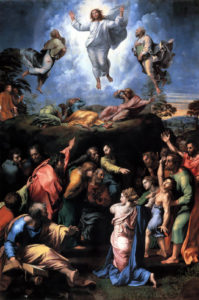The Rev. Noah Van Niel
St. John the Evangelist, Hingham
February 11, 2018
Last Epiphany (B): 2 Kings 2:1-12; Psalm 50: 1-6; 2 Cor 4:3-6; Mark 9:2-9
Buried beneath the hullaballoo surrounding memos and shutdowns and stock market corrections this past week, there was some news of actual interest and it came to us out of the jungles of northern Guatemala. There in the Tikal National Park, home of many of the most famous Mayan temples and ruins in the world, archaeologists made an astonishing discovery. Usi ng a new topographical mapping technique called LiDAR where a plane flies over an area and bounces beams of light incredibly quickly down to the ground and measures how long it takes them to bounce back, computers can generate a remarkably accurate, three-dimensional map of the ground. And what this team of researchers discovered was that in one of the most studied and visited archaeological sites in the world, there were over 60,000 more dwellings, as well as undiscovered canals, tunnels, and temples covered by the dense Guatemalan jungle. This discovery meant that researchers had grossly underestimated the size and complexity of this central Mayan settlement and that instead of 5 million people living in the area, there could have been something like 10-15 million putting this civilization on par with the likes of Ancient Greece or Ancient China for sheer size and sophistication. But over the centuries since this civilization ended, vines and trees and plants and grass had covered all these buildings so completely, no one had ever noticed them. This land that had be walked over countless times by scores of archaeologists who had devoted their whole lives to studying the area was hiding an ancient metropolis right beneath their feet. One Maya specialist was quoted in one articles I read about this discovery as saying, “After decades of combing through the forests, no archaeologists had stumbled across these sites. More importantly, we never had the big picture that this data set gives us. It really pulls back the veil and helps us see the civilization as the ancient Maya saw it.”[1]
ng a new topographical mapping technique called LiDAR where a plane flies over an area and bounces beams of light incredibly quickly down to the ground and measures how long it takes them to bounce back, computers can generate a remarkably accurate, three-dimensional map of the ground. And what this team of researchers discovered was that in one of the most studied and visited archaeological sites in the world, there were over 60,000 more dwellings, as well as undiscovered canals, tunnels, and temples covered by the dense Guatemalan jungle. This discovery meant that researchers had grossly underestimated the size and complexity of this central Mayan settlement and that instead of 5 million people living in the area, there could have been something like 10-15 million putting this civilization on par with the likes of Ancient Greece or Ancient China for sheer size and sophistication. But over the centuries since this civilization ended, vines and trees and plants and grass had covered all these buildings so completely, no one had ever noticed them. This land that had be walked over countless times by scores of archaeologists who had devoted their whole lives to studying the area was hiding an ancient metropolis right beneath their feet. One Maya specialist was quoted in one articles I read about this discovery as saying, “After decades of combing through the forests, no archaeologists had stumbled across these sites. More importantly, we never had the big picture that this data set gives us. It really pulls back the veil and helps us see the civilization as the ancient Maya saw it.”[1]
In his second letter to the Corinthians this morning Paul talks about veils too. About how the jungle of this world has blinded people from seeing the light of the Gospel and the glory of Christ. We know something of this blindness brought on by the busy-ness of this world. For the undergrowth of daily existence can easily cover up that glorious vision of something greater, something magnificent, something timeless right beneath our feet. We can go days, weeks, years, without seeing that there is so much more here for us than the endless cycles of feeding, driving, working, washing, sleeping, repeating. That veil of vines and branches that hid these newly discovered Mayan ruins is not unlike the veil of daily routines and responsibilities that fill our existence with plenty of activity, but very little glory.
When I was in seminary I interned at a small but lively and loving parish in Cambridge where during Lent I lead a Bible study. Not many people showed up, but the few who did were very engaged and engaging and we had a good time. One Sunday we were doing a close reading of a passage from another one of Paul’s letters when Karen looked up from her sheet and said, in her usual bubbly way, “Hmmm, yes, right. And what is glory?” It was one of those questions that was simultaneously incredibly simple and incredibly profound. For on the one hand, what is glory? It’s you know, glory. You know it when you see it. But that’s not actually a terribly helpful definition because it’s more magical a concept than just praise or honor; majesty or splendor. I stammered out some lame response, throwing in some big seminary words to make it sound like I knew what I was talking about, but really I couldn’t give her a good answer to her question. What is glory? It’s a question that’s stuck with me to this day.
Having been an English major in college with a specialty in poetry, a few times a week I like to spend a few minutes reading through some poems. Like a mint that adds a hint of sweetness after a meal, I find it injects a bit of beauty into my day. And a few months ago I came across a poem by Henry Vaughan that I think, finally, gave me the words to answer to Karen’s question. It goes like this:
Happy those early days! when I
Shined in my angel infancy…
When yet I had not walked above
A mile or two from my first love,
And looking back, at that short space,
Could see a glimpse of His bright face;
When on some gilded cloud or flower
My gazing soul would dwell an hour,
And in those weaker glories spy
Some shadows of eternity…
{And} felt through all this fleshly dress
Bright shoots of everlastingness.[2]
That’s what glory is. Glory is those moments shot through with “everlastingness” or glimpses of those “shadows of eternity.” Something is glorious when it causes the lens with which we look upon the world to zoom out and show us the connection to something greater, something bigger, something we can only call divine. When the ground beneath our feet fades away and we see for the first time that these common paths we walk upon day after day hide wonders beyond our wildest imagination.
This Sunday marks the last Sunday of the season after the Epiphany, our final Sunday before Lent. It is marked in the church calendar as Transfiguration Sunday and the Gospel story we always hear is that of Jesus taking his closest disciples up a mountain where they get a glimpse of glory. Jesus, whom they knew so well, with whom they had passed through the dust and dirt of the Judean countryside is transfigured before their eyes and seen, for the briefest of moments, for who he is: the heir of the prophets Elijah and Moses, the Son of God, His Beloved.
Jesus, whom they knew so well, with whom they had passed through the dust and dirt of the Judean countryside is transfigured before their eyes and seen, for the briefest of moments, for who he is: the heir of the prophets Elijah and Moses, the Son of God, His Beloved.
There’s a wisdom in celebrating this glimpse of glory before heading in to the wilderness of Lent. It’s a taste of Resurrection to sustain us through the lean times of self-examination and repentance. But I wonder if “transfiguration” is the right word for what happens on that mountain. Because it gives the impression that somehow Jesus is changed, that he becomes something different than what he was before, and then goes back to being that common man after the moment passes. But that’s not what happens. Instead what happens on that mountain is that Jesus is revealed for who he is and always has been. The grime of his common humanity is stripped away for a moment and what is revealed is not something new, but something true.
We often make the mistake of thinking that we have to go looking far and wide for glory instead of looking for it right under our feet. That those moments of transcendence will only pop up if we put ourselves in uncommon situations doing extraordinary things. And they certainly can happen there. But do not be blind to the glory that is around you all the time. Our lives can feel so glory-less but they’re not. Beneath the undergrowth, if you explore carefully enough, if you shine beams of light across that rocky terrain, you will find wonders just waiting to be discovered. This Lent, look to the glory. Look for those moments where something familiar is revealed as something extraordinary and wonderful; moments where all you can do is smile, and say, “Wow.” Take the time to notice those moments where you felt small and the universe felt big. A moment where you felt more connected to the world around you than usual. A moment of such beauty that it sparkled through the grayness of routine. Then write it down. Keep a list. And after a while you will have a collection of glimpses into the larger life that surrounds us all; a record of glory in your life. It won’t happen every day—we can’t live on the mountaintop—but it will happen more than you think. For glory is not some gift long sought and rarely found. The glory of Christ, revealed upon that holy mountain shines in the well-worn paths of our daily routines and tangled lives. It shines in the people we take for granted for having seen so many times. And it shines in our hearts here, today. It radiates from you, all around you. “For it is the God who said, “Let light shine out of darkness,” who has shone in our hearts to give the light of the knowledge of the glory of God in the face of Jesus Christ.” Look to that glory. Look to the face of that transfigured Christ shining in your midst. “And feel through all this fleshly dress / bright shoots of everlastingness.”
[1] https://news.nationalgeographic.com/2018/02/maya-laser-lidar-guatemala-pacunam/
[2] https://www.poetryfoundation.org/poems/45430/the-retreat-56d2250b6cff5
